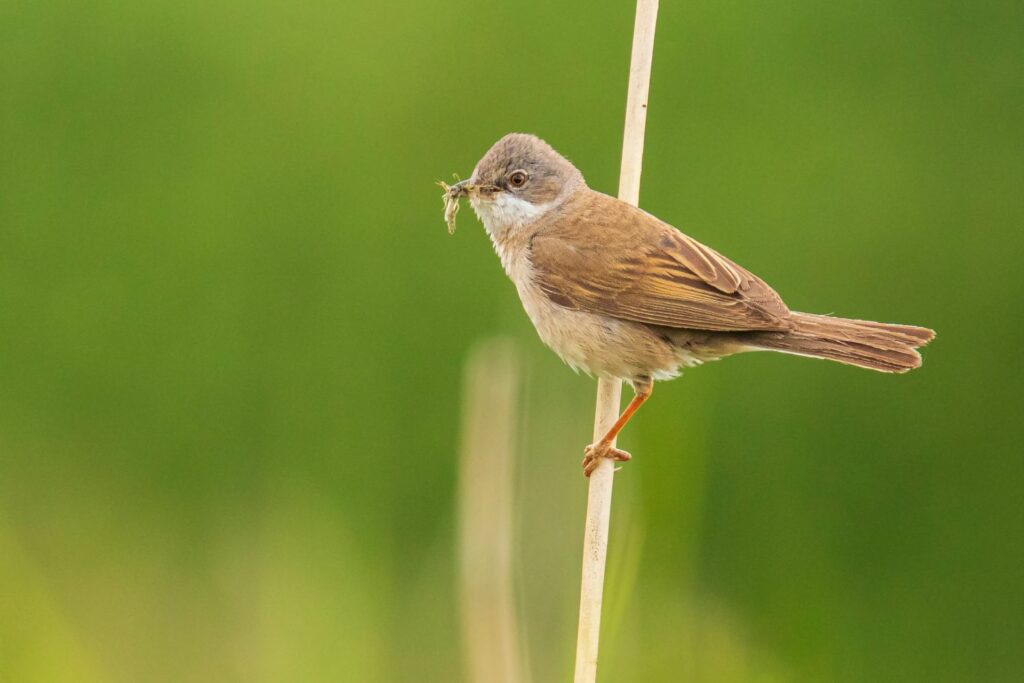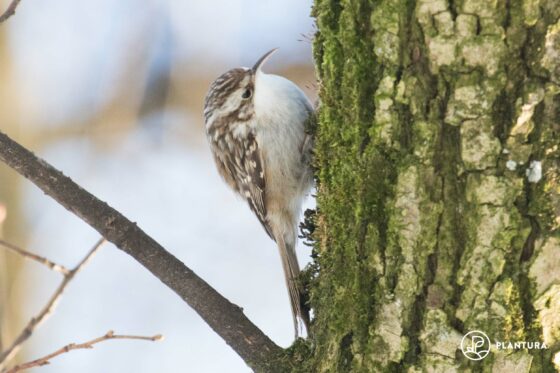Lesser whitethroat: the bird profiles
What does the lesser whitethroat look and sound like? Where does the bird spend the winter? And how can you support it? Find the answers in our bird profile.

The lesser whitethroat (Sylvia curruca) is the smallest of our native warblers. Like its larger relatives, the lesser whitethroat is quite hard to spot and likes to hide in dense vegetation. Just like the blackcap and the garden warbler, it is most easily identified by its song. The bird’s scratchy chortling song almost sounds like the rattling of a mill wheel. Learn how to identify this rattling warbler, when the songbird can be seen in the UK and everything else you need to know about our smallest warbler right here.
Contents
Lesser whitethroat: key facts
| Size | About 12cm |
| Weight | About 12-16g |
| Breeding season | May-June |
| Lifespan | Up to 11 years |
| Habitat | Semi-open landscapes, parks and gardens |
| Diet | Insects |
| Threats | Loss of habitat and food sources |
How to identify the lesser whitethroat
The lesser whitethroat is a rather plain-looking songbird. Its grey-brown upper side contrasts sharply with its pale underside. This is most noticeable between the grey head and the snow-white throat. Some birds also have a tinged, pale stripe over their eyes. However, this feature is rare. Male and female lesser whitethroats have the same colouring and even the young look confusingly similar to their parents after only a short time.

Note: It is very easy to confuse the lesser whitethroat with its cousin the common whitethroat. Although the latter has a somewhat lighter, reddish-brown upper side and less contrasting plumage overall, it is not always easy to tell the two species apart, especially in poor lighting.

What does the lesser whitethroat’s song sound like?
The lesser whitethroat’s song consists of a warbly “tell-tell-tell-tell …”. The bird’s voice can often be heard from dense, low vegetation.

What do lesser whitethroat eggs look like?
Female lesser whitethroats lay between 3 and 5 light-coloured, dark speckled eggs. These are laid in a cup-shaped nest made from stalks, fine roots and other plant fibres.

What is the lesser whitethroat’s ideal habitat?
This warbler prefers semi-open landscapes including forest edges next to open spaces, and cultivated landscapes with scattered hedges or groups of trees. They also feel at home in parks, cemeteries and large wild gardens.
Where does the lesser whitethroat build its nest?
The lesser whitethroat builds its nest in dense vegetation such as hedges, shrubs or conifers. Their open nest is often built just a few metres above the ground.
When is the lesser whitethroat’s breeding season?
Lesser whitethroats breed between May and June. During this time, the birds rear one or two broods. The breeding, rearing and feeding of the young is a team effort – both parents take care of their offspring, which hatch naked and blind after an incubation period of about twelve days. The lesser whitethroat juveniles stay in the nest for a fortnight where they are intensively cared for by their parents. After that, they are already fully grown and make their first attempts to fly the nest.

Where does the lesser whitethroat spend the winter?
As long-distance migratory birds, the lesser whitethroats set off early in the year to cover the long distances to their wintering grounds in East Africa, where the insectivores find sufficient food even in winter. It is not until April that the little warblers return to us. Read our article on migratory birds to discover more about the hardships endured on these long journeys, how the birds navigate their way during migration and lots of other fascinating facts.
Help the lesser whitethroat!
In our increasingly monocultural landscape, dense vegetation and other breeding sites for lesser whitethroats have been declining for a long time. And the continuing decline in insects is also causing problems for the songbirds. Here you can find out how you can support the lesser whitethroat in your own garden.
What do lesser whitethroats eat?
Lesser whitethroats are mainly insectivores, but they sometimes also eat berries and fruit. So unfortunately, you cannot attract the small garden birds with classic bird food made up mainly of grains and seeds.

Instead, you can support lesser whitethroats much better with an insect-friendly garden: by avoiding chemical sprays or by creating a flowering meadow.
What nesting aids are suitable for lesser whitethroats?
Classic closed nest boxes, such as those used for jackdaws or great tits, are not suitable for lesser whitethroats. These warblers prefer open nests, which they make themselves from all kinds of plant fibres. However, you can still support the songbirds in your garden – for example, by letting your hedges and shrubs grow wild and bushy to provide the birds with well-protected nesting sites.
What else can you do to help the lesser whitethroat?
On hot summer days, water is a precious commodity for garden birds. By installing a birdbath, you can support lots of different bird species including the lesser whitethroat. A simple shallow bowl or a saucer does the trick- it does not necessarily have to be an impressive fountain. However, do make sure to clean any form of watering hole regularly, otherwise it can quickly become a breeding ground for bacteria and other pathogens in high temperatures. Clean your watering places daily on hot days.
Another long-distance migrant that only makes its home here in summer and enjoys an abundant supply of insects during this time is the house martin. Get to know this garden bird a little better in our in-depth species profile.

























